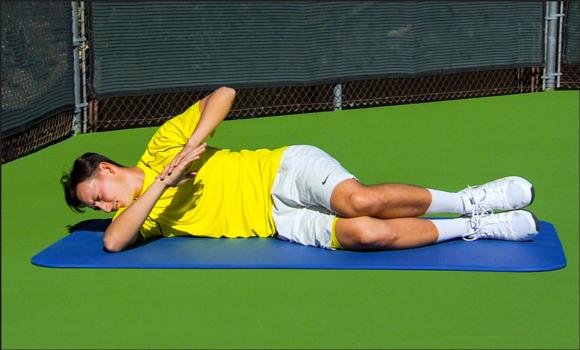Flexibility Training
This is an excerpt from Complete Conditioning for Tennis 2nd Edition With HKPropel Online Video by Mark Kovacs,E Paul Roetert,Todd S Ellenbecker.
Flexibility training is often the most overlooked component of a quality conditioning program. Some of the reasons people do not adhere to flexibility programs include the following:
- Stretching may not feel particularly good.
- The on-court benefits are not obvious to the player.
- Most players have been given no specific individualized guidelines as to how, why, what, and when to stretch.
- Many coaches emphasize stretching less than the other components of conditioning
The term flexibility can be defined as the degree of extensibility of the soft tissue structures surrounding the joint, such as muscles, tendons, and connective tissue. Two main types of flexibility exist. Static flexibility describes the measured range of motion about a joint or series of joints, and dynamic flexibility refers to the active motion about a joint or series of joints. Dynamic flexibility is limited by the resistance to motion of the joint structures, the ability of the soft connective tissues to deform, and neuromuscular components.
Factors influencing flexibility include heredity, neuromuscular components, and tissue temperature. In regard to heredity, body design determines overall flexibility potential. While most people tend to be relatively inflexible, a small few are hyperflexible. Aspects of heredity and body design that affect flexibility potential include the shape and orientation of joint surfaces, as well as the physiological characteristics of the joint capsule, muscles, tendons, and ligaments. In addition, because of the nature of the movements performed while playing tennis and from the repetitive nature of these stresses, some areas of the tennis player's body can be very tight and inflexible. These areas include the hamstrings, low back, and muscles in the back of the shoulder. At the same time, other areas in the tennis player's body may be overly flexible, such as the front of the shoulder (external rotation). These adaptations are the result of many years of playing tennis.
Sleeper Stretch
Focus
Improve flexibility of the shoulder rotators and upper-back (scapular) muscles.
Procedure
- Lie on your dominant shoulder as you would when sleeping on your side.
- Place your dominant arm directly in front of you at a 90-degree angle, keeping the elbow bent 90 degrees as well.
- Using your other arm, push your hand down toward your feet, internally rotating your shoulder (figure 5.15).
- Hold the position for 15 to 30 seconds, then repeat the stretch on the other side.
Note
You can make this stretch even more intense by placing your chin against the front of the shoulder you are lying on, pressing it down even more to provide greater stabilization to increase the stretch.

Sleeper stretch.
Learn more about Complete Conditioning for Tennis.
More Excerpts From Complete Conditioning for Tennis 2nd Edition With HKPropel Online VideoSHOP

Get the latest insights with regular newsletters, plus periodic product information and special insider offers.
JOIN NOW


